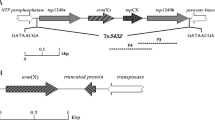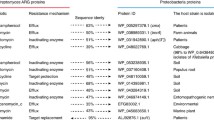Summary
Naturally occurring erythromycin (Em) resistance was found in 11 of the 18 Bacillus licheniformis isolates tested but was absent from a wide variety of other Bacillus strains. The Em resistance elements confer inducible macrolide-lincosamide-streptogramin B (MLS) resistance and are related to ermD an MLS resistance element previously cloned from the chromosome of B. licheniformis 749. The MLS sensitive B. licheniformis strains and the other sensitive Bacillus strains tested, lack sequences with detectable homology to ermD. The sensitive B. licheniformis strains do exhibit homology to sequences which flank ermD in B. licheniformis 749. The relative sizes of the homologous DNA fragments suggest that the sensitive strains are lacking a 3.6 kb segment which contains ermD. It is shown that ermD is homologous to chromosomal DNA from Streptomyces erythreus ATCC 11635, an Em producing organism. These observations suggest to us that MLS resistance may have arisen in the Streptomyces and spread to B. licheniformis another gram positive bacterium found in soil. It is further proposed that ermD is or was located on a transposon-like element and has spread and evolved further to yeild a variety of related Staphylococcal and Streptococcal MLS determinants.
Similar content being viewed by others
References
American Type Culture Collection Catalogue of Strains I. Fifteenth Ed. (1982) Rockville MD
Benveniste R, Davies J (1973) Aminoglycoside antibiotic-inactivating enzymes in actinomycetes similar to those present in clinical isolates of antibiotic-resistant bacteria. Proc Nat Acad Sci USA 70:2276–2280
Chater KF, Hopwood DA, Kieser T, Thompson CJ (1982) In: Current topics in microbiology and immunology, vol 96. Gene cloning in organisms other than E. coli (Hofschneider PH & Goebel W eds) Springer-Verlag, New York, pp 69–95
Clewell DB, Franke AE (1974) Characterization of a plasmid determining resistance to erythromycin, lincomycin, and vernamycin Bα in a strain of Streptococcus pyogenes. Antimicrob Ag Chemother 5:534–537
Courvalin PM, Carlier C, Chabbert YA (1972) Plasmid-linked tetracycline and erythromycin resistance in group D Streptococcus. Ann Inst Pasteur (Paris) 123:755–759
Coyle MB, Minshew BH, Bland JA, Hsu PC (1979) Erythromycin and clindamycin resistance in Corynebacterium diphtheriae from skin lesions. Antimicrob Agents Chemother 16:525–527
Docherty A, Grandi G, Grandi R, Gryczan TJ, Shivakumar AG, Dubnau D (1981) Naturally occurring macrolide-lincosamidestreptogramin B resistance in Bacillus licheniformis. J Bacteriol 145:129–137
Dubnau D, Davidoff-Abelson R (1971) Fate of transforming DNA following uptake by competent Bacillus subtilis. I. Formation and properties of the donor-recipient complex. J Mol Biol 56:209–221
Dubnau DA, Pollock MR (1965) The genetics of Bacillus licheniformis penicillinase: a preliminary analysis from studies on mutation and inter-strain and intra-strain transformations. J Gen Microbiol 41:7–21
Dutta GN, Devriese LA (1981) Macrolide-lincosamide-streptogramin resistance patterns in Clostridium perfringens from animals. Antimicrob Agents Chemother 19:274–278
El-Solh N, Bouanchard DH, Horodniceanu T, Roussel A, Chabbert YA (1979) Molecular studies and possible relatedness between R plasmids from groups B & D Streptococci. Antimicrob Agents Chemother 14:19–23
Fujisawa Y, Weisblum B (1981) A family of r-determinants in Streptomyces spp. that specifies inducible resistance to macrolide lincosamide, and streptogramin type B antibiotics. J Bacteriol 146:621–631
Gordon RE, Haynes WC, Pang CH-N (1973) The Genus Bacillus. Agriculture Handbook No. 427, US Dept of Agriculture, Washington, DC
Graham MY, Weisblum B (1979) 23S ribosomal ribonucleic acid of macrolide-producing streptomycetes contains methylated adenine. J Bacteriol 137:1464–1467
Gryczan TJ, Contente S, Dubnau D (1978) Characterization of Staphylococcus aureus plasmids introduced by transformation into Bacillus subtilis. J Bacteriol 134:318–329
Gryczan TJ, Grandi G, Hahn J, Grandi R, Dubnau D (1980) Conformational alteration of mRNA structure and the post-transcriptional regulation of erythromycin-induced drug resistance. Nucleic Acids Res 8:6081–6097
Gryczan TJ, Israeli-Reches M, Del Bue M, Dubnau D (1984) DNA sequence and regulation of ermD, a macrolide-lincosamidestreptogramin B resistance element from Bacillus licheniformis. Mol Gen Genet 194:349–356
Horinouchi S, Byeon W, Weisblum B (1983) A complex attenuator regulates inducible resistance to macrolides, lincosamides, and streptogramin type B antibiotics in Streptococcus sanguis. J Bacteriol 154:1252–1262
Horinouchi S, Weisblum B (1980) Posttranscriptional modification of mRNA conformation: mechanism that regulates erythromycin-induced resistance. Proc Natl Acad Sci USA 77:7079–7083
Lai C-J, Weisblum B (1971) Altered methylation of ribosomal RNA in an erythromycin-resistant strain of Staphylococcus aureus. Proc Natl Acad Sci USA 856–860
Lai C-J, Dahlberg JE, Weisblum B (1973a) Structure of an inducibly methylatable nucleotide sequence in 23S ribosomal ribonucleic acid from erythromycin-resistant Staphylococcus aureus. Biochemistry 12:457–460
Lai C-J, Weisblum B, Fahnestock SR, Nomura M (1973b) Alteration of 23S ribosomal RNA and erythromycin-induced resistance to lincomycin and spiramycin in Staphylococcus aureus. Mol Biol 74:67–72
Mahler I, Halvorson HO (1980) Two erythromycin-resistance plasmids of diverse origin and their effect on sporulation in Bacillus subtilis. J Gen Microb 120:259–263
Malke H, Reichardt W, Hartmann M, Walter F (1981) Genetic study of plasmid-associated zonal resistance to lincomycin in Streptococcus pyogenes. Antimicrob Agents Chemother 19 (No. 1): 91–100
Marmur J, Doty P (1962) Determination of the base composition of deoxyribonucleic acid from its thermal denaturation temperature. J Mol Biol 5:109–118
Otaya H (1971) Epidemiological study of erythromycin resistance in Staphylococcus aureus in Japan. In: S. Mitsuhashi (ed) Drug action and drug resistance in bacteria. University Park Press, Baltimore
Ounissi H, Courvalin P (1981) Classification of Macrolide-lincosamide-streptogramin-B-type antibiotic resistance determinants. Ann Microbiol (Inst Pasteur) 132B:441–454
Rigby PWJ, Dieckmann M, Rhodes C, Berg P (1977) Labeling deoxyribonucleic acid to high specific activity in vitro by nick translation with DNA polymerase, I. J Mol Biol 113:237–251
Schleiff RF, Wensink PC (1981) Practical methods in molecular biology. Springer-Verlag New York Inc
Shivakumar AG, Dubnau D (1981) Characterization of a plasmidspecified ribosome methylase associated with macrolide resistance. Nucleic Acid Res 9:2549–2562
Skinner RH, Cundliffe E (1982) Dimethylation of adenine and the resistance of Streptomyces erythraeus to erythromycin. J Gen Microbiol 128:2411–2416
Southern EM (1975) Detection of specific sequences among DNA fragments separated by gel electrophoresis. J Mol Biol 98:503–517
Thompson CJ, Gray GS (1983) Nucleotide sequence of a streptomycete aminoglycoside phosphotransferase gene and its relationship to phosphotransferases encoded by resistance plasmids. Proc Natl Acad Sci USA 80:5190–5194
Thompson CJ, Kieser T, Ward JM, Hopwood DA (1982) Physical analysis of antibiotic-resistance genes from Streptomyces and their use in vector construction. Gene 20:51–62
Weisblum B (1971) Macrolide resistance in Staphylococcus aureus. In: Drug action and drug resistance in bacteria. I. Macrolide antibiotics and lincomycin (Mitsuhashi S ed) University Park Press, Baltimore, pp 217–238
Weisblum B, Graham MY, Gryczan T, Dubnau D (1979a) Plasmid copy number control: Isolation and characterization of highcopy-number mutants of plasmid pE194. J Bacteriol 137:635–643
Weisblum B, Holder SB, Halling SM (1979b) Deoxyribonucleic acid sequence common to staphylococcal and streptococcal plasmids which specify erythromycin resistance. J Bacteriol 138: 990–998
Weisblum B, Siddhikol C, Lai C-J, Demohn V (1971) Erythromycin-inducible resistance in Staphylococcus aureus: requirements for induction. J Bacteriol 106:835–847
Welch RA, Jones KR, Macrina FL (1979) Transferable lincosamide-macrolide resistance in Bacteroides. Plasmid 2:261–268
Yagi Y, Franke AE, Clewell DB (1975) Plasmid determined resistance to erythromycin: comparison of strains of Streptococcus faecalis and Streptomyces pyogenes with regard to plasmid homology and resistance inducibility. Antimicrob Agents Chemother 7:871–873
Yagi Y, McLellan TS, Frez WA, Clewell DB (1978) Characterization of a small plasmid determining resistance to erythromycin, lincomycin and vernamycin B in a strain of Streptococcus sanguis isolated from dental plaque. Antimicrob Agents Chemother 13:884–887
Youngman PJ, Perkins JP, Losick R (1983) Genetic transposition and insertional mutagenesis in Bacillus subtilis with Streptococcus faecalis transposon Tn917. Proc Natl Acad Sci USA 80:2305–2309
Author information
Authors and Affiliations
Additional information
Communicated by A. Bukhari
Rights and permissions
About this article
Cite this article
Israeli-Reches, M., Weinrauch, Y. & Dubnau, D. Evolutionary relationship of the Bacillus licheniformis macrolide-lincosamide-streptogramin B resistance elements. Molec. Gen. Genet. 194, 362–367 (1984). https://doi.org/10.1007/BF00425545
Received:
Issue Date:
DOI: https://doi.org/10.1007/BF00425545




